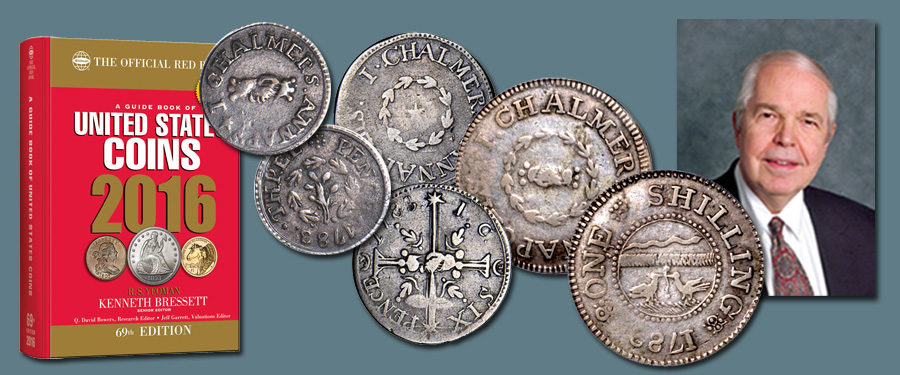
In this article I continue my tour through the very useful Guide Book of United States Coins, focusing this week on the John Chalmers issues. As listed on pages 50-51, these are available in six different basic types. The threepence is the smallest denomination, followed by the sixpence of which Small Date and Large Date varieties are listed, followed by the shilling with either long worm or short worm, and then a shilling rarity with five rings. Regarding the worm, or is it a snake (it has a head like a snake), two birds are competing for ownership of it. For practical purposes a collection today can consist of three pieces: a threepence, a sixpence and a shilling. Colonial and early American coins are often best collected by types, as varieties are often extensive (not so much in this series, however) and can be expensive.
John Chalmers was a goldsmith and silversmith in Annapolis, Maryland, who issued coins of his own design. Thomas Sparrow, an engraver who also made bank note plates, seems to have engraved some or all of the dies. An early mention of these coins is found in a book, Travels in the Confederation, 1783-1784, by Dr. Johann David Schoepf, who visited Chalmers and exchanged various fractional parts of Spanish-American coins for Chalmers’ coins, paying a commission to do so.
The building in which these were coined stood at Fleet and Cornhill streets. Although they had no official status and were privately issued, no exception was taken to them by the United States government, the Treasury of which was just getting underway. Original coinage was probably quite extensive, as several hundred examples are known today, most showing evidence of considerable use in commerce, Very Fine being a typical grade.
The shilling denomination seems to have been produced in the largest quantity, as these are the most seen. There must have been some sort of meaning to the birds and worm (or snake), as scenes on early tokens and money often were allegorical, the best known of which are the mottos and devices on Continental currency notes. These coins have been the object of study by many collectors over a period of time. An informative article by Henry Schab, “The Life and Coins of John Chalmers,” in The Numismatist, November 1984 is particularly useful.
I will continue next week with French New World issues starting on page 51.





